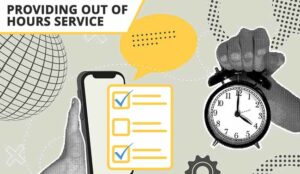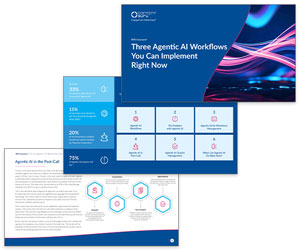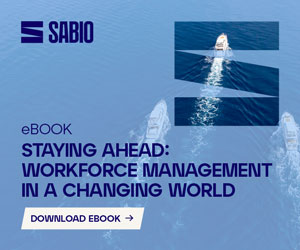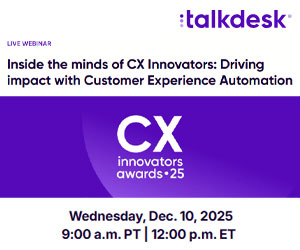Customer self-service is no longer a nice-to-have – it’s an expectation. But without the right design and execution, it can lead to endless frustration!
So, how can organizations get it right, so it’s the ultimate win–win for customer experience AND efficiency gains?
To find out, we asked the technology experts what it really takes to deliver top-notch self-service.
Automate Full Workflows – Not Just Single Questions

Deliver more effective self-service by enabling your virtual agent to resolve full customer journeys, not just answer single questions.
Start by mapping your most common multi-step workflows, such as “change an order and confirm shipping” or “update billing information and process payment”, rather than focusing solely on FAQs.
Then equip the virtual agent with the specific API tools it needs to complete every step of those workflows. This shifts automation from being a basic information source to a fully capable virtual agent that can resolve issues from start to finish.
Contributed by: Shaun McCurdy, Virtual Agent Product Manager, Enghouse
Guide Customers to Relevant Answers (Instead of Generic Content They’ve Likely Already Found)

All our customers talk about self-service because their customers expect it. But while people want an effective self-service option, they don’t want to be forced into it. The balance lies between empowering users and making them feel pushed away.
The key is understanding who the customer is when they engage. Self-service users are often exchanging time for clarity – investing effort to find an answer they can trust.
Unlike a conversation with a person, where nuance and follow-up questions build confidence, self-service depends on how well you already know the user.

Companies that use that context – who they are, what they own, and what’s happened before – can guide them quickly to relevant, trustworthy answers instead of generic content they’ve likely already found.
Exploratory self-help is easy; self-help in a moment of need is not. When customers seek answers under pressure, your ability to recognize and anticipate them before they even start makes all the difference.
Contributed by: Ryan Toben, SVP of Customer Success & Account Management, and Paul Hannan, Director – Learning Studio at Calabrio
Ask Yourself If the Channel Is Really Suitable for the Task in Hand

To get customer service right, you should always start with channel adoption.
Assess whether customers are already comfortable with the channel. Are they using webchat, messaging apps, mobile apps, or voice?
After all, forcing behaviour change creates friction and reduces adoption, which ultimately limits the value of self-service – so meet customers where they already are.
You also need to consider if the channel that’s going to be used for self-service is suitable for the enquiry.
Not all channels fit all tasks! Simple transactional enquiries are ideal for chatbots or app-based flows. In contrast, complex or emotionally charged interactions may be better suited for voice or assisted service.
Contributed by: Lisa Orford, VP for Contact Centre, 8×8
Don’t Just Jump Into Automation – Pinpoint Pain Points and Recurring Issues First!

The best first use of AI isn’t immediate automation; it’s conversation intelligence and analytics. Use AI analytics to extract the “truth” in your customer conversations – pinpointing pain points, intent, recurring issues, and blind spots.
This rich, actionable data is the blueprint for architecting a fundamentally improved customer experience (CX) and by fixing the underlying CX and process flaws first, you create a healthy foundation that allows AI and virtual agents to truly scale and deliver the personalized, efficient service your customers will love.
Contributed by: Matthew Clare, VP, Product Marketing, UJET
Avoid the Dreaded “Loop of No Escape”

The best self-service experiences balance automation with human connection – for instance, chatbots that can resolve simple issues but seamlessly hand off to agents when needed.
Avoid the dreaded “loop of no escape” by ensuring customers can easily transition to live support.
Give agents full visibility into what’s already been tried too, so customers never have to repeat themselves.
Contributed by: Jonathan Kenu Escobedo, Customer Success Manager, MiaRec
Continually Test Usability With Real Customers

Building your self-service experience around real customer needs can improve customer satisfaction by minimizing the likelihood of escalations.
Start by looking at historical data and analysing transcripts, search terms, and call logs to identify recurring questions and failure points. Once you have identified the problems, start tailoring your chatbot scripts based on them.
Use plain language, embed multimedia (how-to videos, infographics), and continually test usability with real customers. This can help turn scripted interactions into more humanized, smart conversations, enhancing the overall self-service experience.
Contributed by: Zainab Ahmed, Marketing Manager, Peopleware
Watch the video below to hear Stuart Baker, WFM Solution Consultant at Peopleware, explain why the real goal of self-service is to help customers get something done quickly:
Start Small and Test Simple Use Cases to Help Refine Your Offering

Start small! Test simple use cases and document the outcomes to help refine your offering, and then mystery shop your own services to experience your communications first hand.
Additionally, take advantage of frontline teams, who are a goldmine of insight – ask what customers frequently request, and what frustrates or delights them.
All of this data enables you to create a robust knowledge base which you can then use to continually improve and tailor your services for your customers.
Contributed by: Ben Smith, Senior Technical Solution Consultant, Route 101
Did you know? Self-service continues to reign king on perceived ROI – according to our latest research:

Stop Building Your Self-Service Offerings Around What the Business Wants!

Great self-service starts with your customer and the channels they want to engage on, not your organization.
Sadly, many businesses still build self-service based on current business processes and channels, rather than what customers actually want!
Self-service can be transformative, but it should always start with reviewing your processes, walking through journeys and quantifying impact.
Your approach must also continually evolve as your services, technology and customer expectations change.
When self-service is truly customer-centric, you reduce effort, build trust and strengthen CX.
Contributed by: Lewis Gallagher, Senior Solutions Consultant, Netcall
Remember, Humans Adapt Through Gradual Increments – Not Leaps!

Customers embrace self-service but only within the bounds of what feels natural. Successful self-service therefore starts with understanding existing human behaviour and working from there, rather than trying to impose change.
The failure of Amazon Fresh in the UK demonstrates that when systems move too far from familiar behaviours, adoption falters.
After all, customers could cope with the step from a manned till to a self-service till, but the processes around helping themselves in store and then walking out represented, almost literally, a step too far.
The same applies in CX: humans adapt through gradual increments, not leaps. Think of how communication has evolved sequentially, from letters to email, and then to WhatsApp; each step a small, intuitive shift from the last.
People already value the speed and convenience of self-service for simple requests, and some are now confident directing more important enquiries through automated processes, but they still want human contact for their complex, urgent or emotional issues.
Organizations wishing to expand self-service offers should start from this premise: letting people communicate with the automated system as if with another person, talking or writing intuitively through natural language processing (NLP), and with the option to transition to a human service agent where necessary.
Contributed by: Martin Taylor, Co-Founder and Deputy CEO, Content Guru
Watch the video below to hear Sam Fuller, Customer Success Director at Content Guru, outline five ways to excel in self service:
Great Self-Service Truly Empowers Customers
When done well, self-service empowers customers, driving efficiency, satisfaction, and loyalty.
Are you getting the balance right in your contact centre?
For more great insights and advice from our panel of experts, read these articles next:
- What’s Happening With Forecasting Right Now?
- Stay Ahead in QA and Call Recording
- How to Nail Your Outbound Strategy
Author: Megan Jones
Reviewed by: Jo Robinson
Published On: 18th Nov 2025 - Last modified: 9th Dec 2025
Read more about - Technology, 8x8, Calabrio, Content Guru, Enghouse Interactive, Jonathan Kenu Escobedo, Lewis Gallagher, Lisa Orford, Martin Taylor, Matthew Clare, MiaRec, Netcall, Route 101, Shaun McCurdy, Stuart Baker, Top Story, UJET, Zainab Ahmed











































